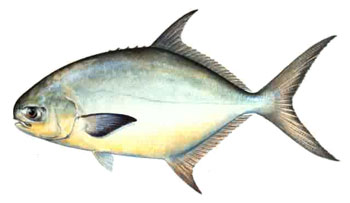
Trachinotus carolinus
Pompano, Carolina Pompano
The Florida Pompano is a beautifully colored, delicately textured member of the Carangidae family of jacks and is highly esteemed as a food fish. Unlike most jacks, it lacks scutes on the caudal peduncle and may also be identified by its short, blunt snout. It is one of the few fish that is more vividly colored after death than when alive. The belly and fins are a beautiful golden hue and the sides are whitish-platinum. When removed from the water the body is dark green-blue above and silvery-white below.
Juvenile Florida pompano feed on pelagic invertebrates amphipods, crab larvae, copepods, isopods, and young fishes. Adults eat small surf clams (coquinas), amphipods, crabs, shrimps, and mussels.
Despite its name, the Florida Pompano's range extends from Massachusetts to Brazil, although the species is more common south of Virginia and the Gulf of Mexico. It occurs irregularly in the West Indies.
The Florida Pompano can be found inshore and near shore, especially along sandy beaches, along oyster banks, and over grass beds. They are often in turbid water and may be found in water as deep as 130 feet.
The Florida Pompano rarely grows larger than 6 pounds and 25 inches long, and usually weighs less than 3 pounds. They can grow up to 8 pounds.
8 pounds, 4 ounces (IGFA)